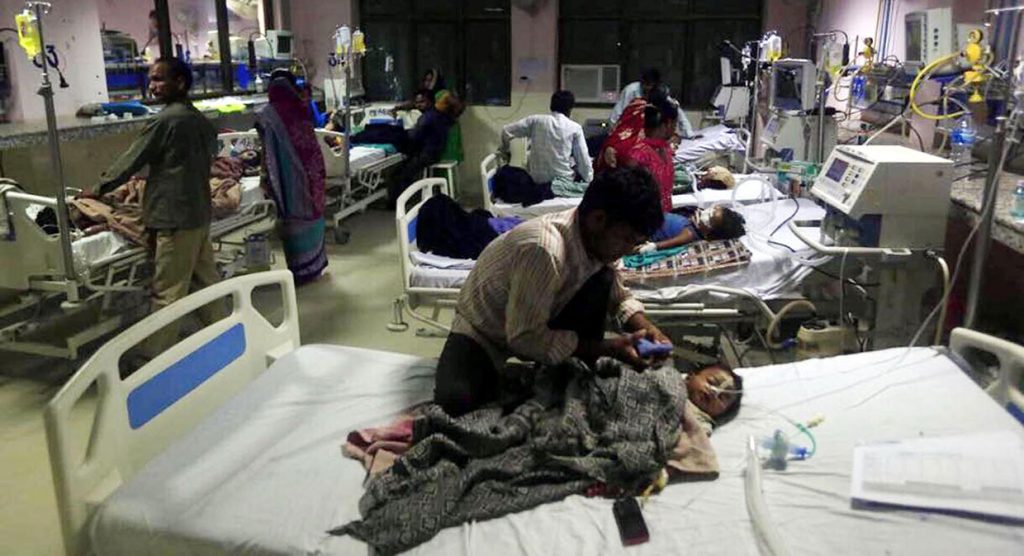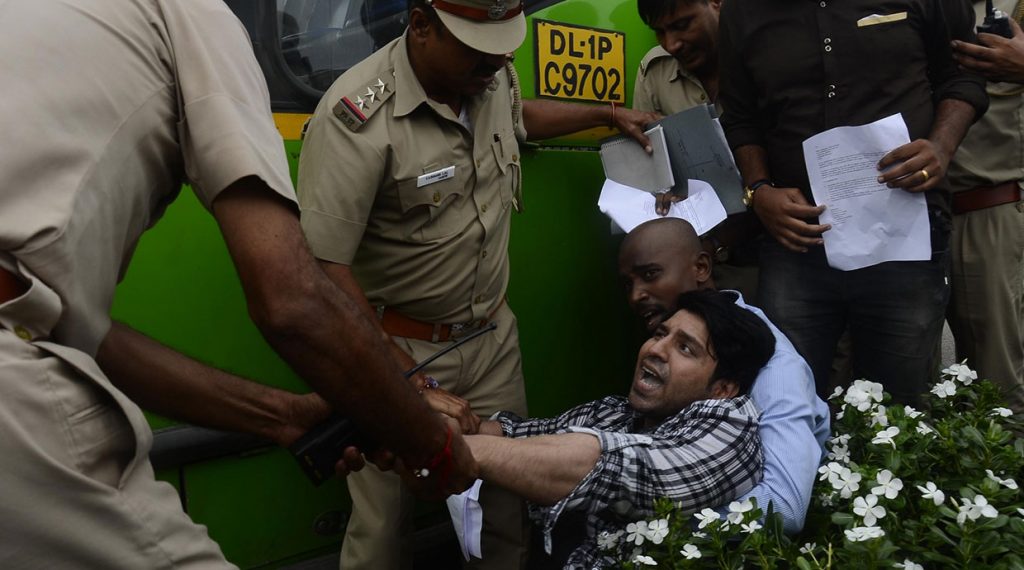Crime
The Night the Oxygen Ran Out in an Indian Hospital

Relatives mourn outside the Baba Raghav Das Medical College (BRDMC) Hospital in Gorakhpur on Aug 11, 2017.
Photo Credit: IANS
The death of 60 children in a Gorakhpur sparks outrage.
It was around 6 a.m. last Friday, said Mohamed Jahid — the father of a very sick little girl being treated at a government hospital — when the oxygen stopped. The situation was desperate, but the parents of children in the intensive care unit did not panic, because they had no idea what was going on.
Most were villagers like Jahid, who said they all thought it was normal procedure when the nurses unhooked the ventilators that had been helping keep their children alive, handed out small plastic hand-operated resuscitators and quickly showed the parents how to use them.
With his daughter gasping for air, Jahid got right to work.
“I pumped and pumped,” he said. He looked around the ward. All the parents were pumping and pumping. Unbeknown to them, the hospital’s supplies of oxygen had been steadily dwindling, after the supplier cut off shipments of liquid oxygen for lack of payment. On Friday, despite repeated warnings from the supplier and hospital technicians, the oxygen ran out.
 A view of children admitted at the Baba Raghav Das Medical College (BRDMC) hospital in Gorakhpur on Aug 12, 2017.
A view of children admitted at the Baba Raghav Das Medical College (BRDMC) hospital in Gorakhpur on Aug 12, 2017.
Photo Credit: IANS
By the time the flow was stabilized, more than 60 children had died. Many were sick with Japanese encephalitis and other tropical diseases and may have died from other causes, but doctors admitted that the oxygen interruption is likely to have claimed at least several lives.
The children’s deaths have become a national outrage, headlining front pages of all the major newspapers and marring celebrations this week of India’s 70th anniversary of independence.
The government hospital, part of the larger Baba Raghav Das Medical College in Gorakhpur, was considered the area’s best, a beacon to millions of people. It is now a symbol of India’s swamped, mismanaged and often corrupt public health care system. As this episode underscored, the system is so enormous and has so many people moving through it that mistakes are often not corrected until many lives are lost.
The medical college is a monument to that sense of scale. It is a hulking, sprawling network of buildings with nearly 1,000 beds and 10-foot-wide corridors a city block long. With such a deluge of patients, some coming from hundreds of miles away, doctors sometimes work 36-hour double shifts with just a six-hour break, and children are crammed two or three to a bed. Families are camped out everywhere, their bedrolls, blankets, water jugs and round steel food tins clogging the hallways.
The case has cast a glare on the government of Prime Minister Narendra Modi, in no small part because Gorakhpur is the home turf of one of Modi’s most contentious allies, Yogi Adityanath. A divisive politician and Hindu ascetic, Adityanath recently became chief minister of India’s most populous state, Uttar Pradesh, which, at 200 million, has more people than all but a handful of the world’s nations.
The state government’s initial response to the oxygen fiasco was to imply that it was perfectly normal for 10 children to die every day at the Gorakhpur hospital, especially at this time of year, the rainy season, when swarms of mosquitoes spread deadly Japanese encephalitis, a virus that causes brain swelling and seizures.
 Police detains a volunteer protesting against deaths of 60 children at a Gorakhpur hospital, in New Delhi on Aug 12, 2017.
Police detains a volunteer protesting against deaths of 60 children at a Gorakhpur hospital, in New Delhi on Aug 12, 2017.
Photo Credit: IANS
That explanation was widely criticized as the height of insensitivity. “Who have we become?” asked Pratap Bhanu Mehta, a leading commentator, in a recent column. “In our republic poor children are fated to die.”
The government response continues to be confused. Adityanath’s administration is adamant that the oxygen problem was not responsible for any deaths, even though no autopsies were performed. At the same time, it has suspended the head of the medical college and called for a full investigation.
Lying just south of the India-Nepal border, Gorakhpur is very lush, especially now, during the monsoon. Some parts of it are beautiful, with dripping banyan trees, brightly painted houses and new shops. There’s even a Domino’s pizza place. But in other areas, stagnant water covers the roads and garbage is stuffed into every nook and cranny — between houses, along riverbanks, heaped up in vacant lots. Entire neighborhoods seem to be sinking under piles of their own waste.
The town is surrounded by wet green rice fields that during the rainy season are infested with mosquitoes.
Brahamdev Yadav, a rice farmer, had never heard of Japanese encephalitis. But by putting his hand to the foreheads of his newborn twins, he could tell they were sick.
He checked them into the hospital on Aug. 3, around the same time that the hospital’s oxygen supplier was issuing increasingly urgent pleas for payment. In a string of letters to the medical college, the Indian media reported, the supplier insisted it had its own bills to cover and could not keep delivering liquid oxygen for the hospital’s central oxygen system unless a $100,000 bill was settled.
In India, public officials often squeeze their vendors for “commissions.” It is widely acknowledged that even after public contracts are awarded, vendors have to grovel for payment, and that the best way to lubricate the bureaucracy is to give the officials in charge a 2 to 5 percent cut. When asked whom they blamed for the tragedy, several parents of children who died in the oxygen shortage said simply, “corruption.”
The head of the medical college, R.K. Mishra, who has resigned, was under suspicion for misusing public money, Indian news outlets reported. In this same part of India, millions of dollars have vanished in other public health corruption scandals.
The medical college clearly needs all the funds it can get. While a new Japanese encephalitis wing is state of the art, with its plate glass windows and beeping machines, other parts of the hospital are in chaotic disrepair. Giant holes have been punched in the walls, the wide corridors reek of urine, many lights have burned out and water drips from the ceiling, pooling on the floor.
The hospital is “overburdened 10 times,” said Dr. K.P. Kushwaha, former head of the medical college.
Doctors said that many Indian hospitals are like this, often with deadly consequences. In 2011, 16 new mothers died at one crowded hospital in Jodhpur before it was discovered that many intravenous fluid bags were contaminated with bacteria. That same year, 22 babies died at another hospital over a four-day period, though the cause remains unclear.
On Thursday night, Jahid arrived at the medical college with his 5-year-old daughter burning with fever and struggling to breathe. This was just hours after the Gorakhpur Newsline, a website featuring local news, published an article warning that the hospital’s oxygen supply was about to run out.
Jahid, a jewelry salesman, had not seen that report. Like most others with children at the hospital, he had passed through several smaller facilities before getting there.
“They told me, ‘Take her to the medical college, where there are good doctors and machines, and she’ll be OK,’” he recalled. He said the oxygen cut out five times on Friday.
Around this time, Yadav’s newborn twins died. Both of them had been on ventilators. They were 10 days old, and did not even have names. “I thought about killing myself,” Yadav said.
As news of the children’s deaths spread, the hospital scrambled to make a partial payment. Liquid oxygen was delivered Saturday morning and hospital officials insist there was only a two-hour gap between 11:30 p.m. Thursday and 1:30 a.m. Friday without a central oxygen supply.
They say they brought in cylinders of compressed oxygen during the shortage and kept the oxygen flowing to crucial areas, like the intensive care unit. But several parents disputed that, saying the oxygen flow had not been restored until Friday evening, when journalists with video cameras showed up.
Several pediatricians interviewed at the hospital said it would be difficult to pinpoint a cause for each of the more than 60 child deaths last week, but that the oxygen cutoff by itself claimed at least two or three lives.
Jahid is haunted by thoughts about what he could have done differently. Sitting at home, holding a picture of his daughter, Khushi, he said he had squeezed the manual resuscitator as best he could.
“She was so affectionate,” said her grandfather, Ilahi. “She would bring me tea, she would bring me food, she would bring me water.”
He gazed into the alleyway in front of the family home, seeming to see her out there again, walking toward him, and said softly, “She was like my hand.”
© 2017 New York Times News Service
